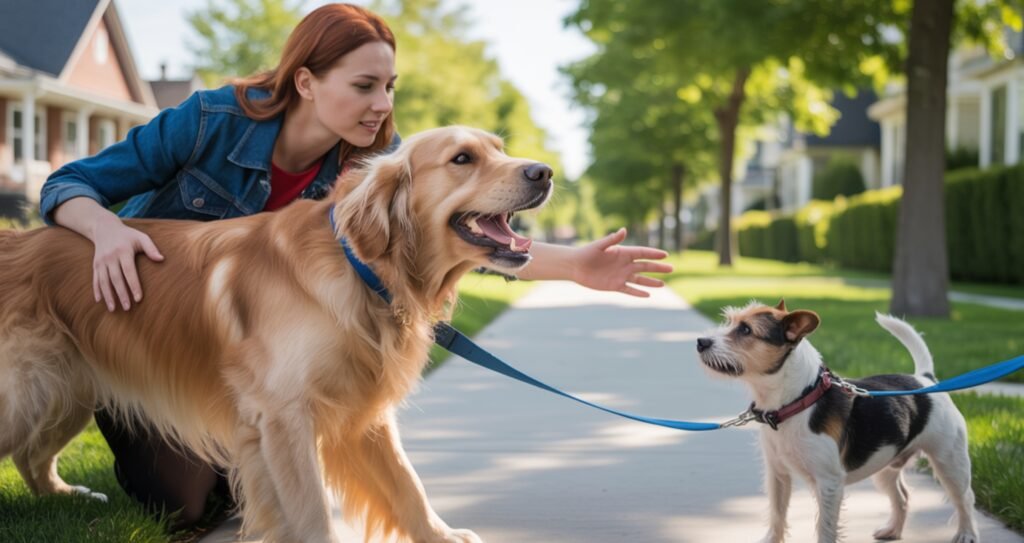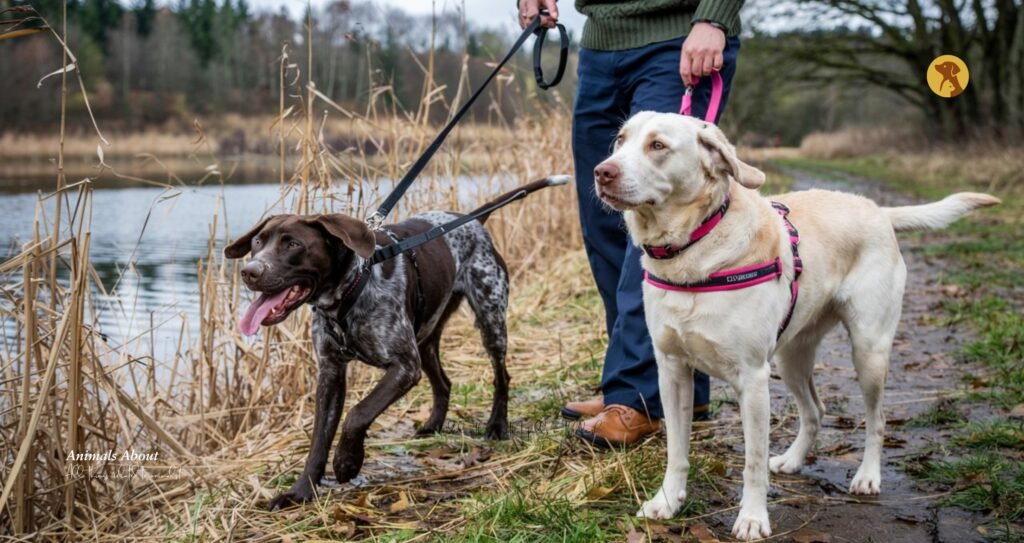Dog Barking on Walks: Why It Happens and How to Stop It

For many dog owners, taking a walk with their furry friend is one of the highlights of the day. It’s not just exercise, it’s bonding time, mental stimulation, and a chance for your dog to explore the world. But when your dog barking on walks, it can turn a peaceful outing into a stressful and embarrassing ordeal. You might be wondering: Why is my dog barking while walking? Whether they’re barking at other dogs, strangers, cars, or seemingly nothing at all, there’s always a reason behind the behavior. In this post, we’ll explore the common causes of dog barking on walks, explain the science behind canine communication, and share proven strategies to help calm your dog down. Why Does Dog Barking on Walks Happen? Barking Is a Form of Communication Barking is how dogs talk. Whether it’s excitement, frustration, fear, or a warning, your dog is trying to say something. Understanding reactive dog behavior and the root cause of barking is the first step toward managing it. Common Reasons for Barking at Other Dog Barking on Walks Let’s look at the most common behavioral causes: 1. Leash Reactivity Leash reactivity is one of the most common reasons dogs bark on walks. When leashed, a dog might feel trapped and more likely to bark at triggers like other dogs or strangers. Without the ability to move freely, your dog may resort to vocalizing their discomfort. Symptoms of leash reactivity include: This type of behavior doesn’t necessarily mean your dog is aggressive. It’s often based on frustration, over-excitement, or fear. 2. Fear-Based Barking If your dog starts barking every time someone new walks by or when loud sounds occur, it might be due to dog anxiety during walks. This fear-based barking usually stems from: Dogs with fear issues are not being “bad” they’re simply scared and unsure of how to react. 3. Territorial Aggression Dogs are naturally protective. On walks, some dogs see certain areas as “their territory,” especially when near their home. Territorial aggression leads to barking at people, dogs, or even cars passing by. This instinct is stronger in certain breeds but can occur in any dog without proper training. 4. Excitement and Lack of Training Your dog may simply be barking while walking out of sheer joy or frustration. If they haven’t been taught how to behave on walks, they may bark to express excitement when seeing another dog or a squirrel or just to get your attention. Recognizing Behavioral Triggers in Dog Barking on Walks Before you can fix the barking, you need to identify what’s causing it. Observe your dog’s behavior and ask: Common behavioral triggers include: Keep a log of your walks to identify patterns. This can be extremely helpful when working on a dog barking solution. How to Stop Dog Barking on Walks Once you understand why your dog barks on walks, you can use targeted training to help manage the behavior. ✅ 1. Use Positive Reinforcement Training to Reduce Dog Barking on Walks Never punish your dog for barking. Instead, use dog training tips grounded in positive reinforcement: Tip: Use the “Look at Me” command to redirect their attention when they start to focus on a trigger. ✅ 2. Practice Desensitization and Counterconditioning for Barking During Walks These techniques help dogs build neutral or positive associations with their triggers: Desensitization: Gradually expose your dog to the trigger at a distance where they don’t react. Slowly decrease the distance over time. Counter-conditioning: Pair the presence of a trigger with something your dog loves (like a treat). Over time, your dog will associate the trigger with something good rather than a threat. ✅ 3. Create Distance from Barking Triggers on Walks Sometimes, simply walking your dog further away from the trigger can prevent barking. Cross the street, change direction, or put yourself between your dog and the trigger. This reduces pressure and gives your dog more space to calm down. ✅ 4. Use Calming Techniques for Dogs If your dog is frequently anxious, try: Combining these calming techniques for dogs with behavior training can have a powerful impact. ✅ 5. Improve Socialization to Prevent Excessive Barking on Walks Early and continued socialization in dogs helps prevent reactivity and fear. If your dog didn’t have much exposure to other dogs or people as a puppy, they might struggle now. Help them gradually meet new people, experience different places, and interact with calm, well-mannered dogs. Tools That Can Help If you’re struggling, a few tools can support your training efforts: These tools don’t fix behavior on their own but can support proper training methods. When to Consult a Professional If your dog’s barking is aggressive, unmanageable, or getting worse, it’s a smart move to seek help. A certified dog trainer or behaviorist can: Especially in cases of aggressive dog on leash issues, professional help can make a big difference. Preventing Future Problems Dog Barking on Walks The best way to deal with dog behavior on leash is to prevent bad habits from forming. Here’s how: Also, make sure your dog’s daily needs are met. A tired, mentally stimulated dog is far less likely to act out. Provide: End Dog barking on walks is a common issue but it doesn’t have to be permanent. Whether it’s leash reactivity, fear-based barking, or territorial aggression, understanding the root cause is key. Use positive training, understand your dog’s triggers, and work at their pace. With time, patience, and the right techniques, you’ll turn those stressful, noisy walks into peaceful, joyful outings you both look forward to. Every bark tells a story. It’s your job to listen, learn, and guide your dog toward better behavior.
How to Deal with a Dog That Pulls on the Leash: Proven Solutions for Calm Walks

Are daily walks turning into a stressful tug-of-war? Does your Dog Pulling Leash on the leash the moment you step outside? You’re not alone. “Dog pulling leash” is one of pet parents’ most common struggles. But don’t worry—whether your dog is strong, stubborn, or simply overexcited, there are effective and humane ways to regain control and enjoy your walks again. Using tools, commands, and proper training techniques, let’s explore powerful, positive, and practical methods to correct your Dog Pulling Leash behavior. With consistency and the right knowledge, even the most leash-reactive dog can learn to walk calmly by your side. Why Does Your Dog Pull on the Leash? Walking a dog that pulls can be exhausting. But have you ever wondered why your dog behaves this way? Dogs pull because they’re excited, curious, and often unaware that they’re doing something wrong. The world is full of exciting smells, sights, and sounds. Without proper leash manners, they assume pulling is how they get where they want to go—faster. Some dogs also pull because they haven’t been taught loose leash walking tips. Others do it out of frustration or leash reactivity, especially when seeing other dogs. Whatever the reason, it’s important to address the behavior early and effectively. For example, certain energetic breeds like Labradors often display leash-pulling behavior when not properly trained. Learn more about their typical traits and how to handle them in our article on Labrador Retriever puppies’ behavior. How to Stop Leash Pulling: Immediate Actions You Can Take To stop leash pulling, you must stop reinforcing the behavior. The moment your dog starts to pull—stop walking. Stand still and wait. Only move forward once the leash slackens. This teaches your dog that pulling halts progress, while walking nicely earns rewards. Use positive reinforcement leash training to reward good behavior. Bring high-value treats and praise your dog when they walk beside you. Stay calm and patient. Training doesn’t have to be perfect—it just needs to be consistent. Pro Tip: If your dog is pulling like a sled dog, switch to a dog harness for pullers. It reduces pressure on your dog’s neck and gives you more control. Leash Training a Dog: Step-by-Step for Lasting Results If you’re wondering how to train a dog to walk calmly, follow this simple, effective structure: This method works for dogs of all ages, but the sooner you start dog walk obedience training, the easier it becomes. Dog Walking Behavior: Replace Chaos with Calm Dogs don’t naturally understand how to behave on a leash. It’s your job to teach them proper dog walking behavior using clear guidance and repetition. Command training, like “heel” or “let’s go,” helps your dog focus on you during walks. Teaching your dog to heel might seem like a challenge, but it’s a powerful way to promote calm walking behavior. Use a treat near your knee to guide your dog, and say “heel” when they match your pace. Reward generously at first. Over time, your dog will associate walking by your side with good things. Tools and Solutions to Stop Pulling on Walks Sometimes training alone isn’t enough. The right tools can make a huge difference in your journey. Here are a few proven leash pulling solutions: A strong dog needs the best leash for strong dogs that’s built to last. Choose one that offers grip, control, and comfort. Teaching Dog to Heel and Walk Nicely Many pet owners overlook the importance of structured walking. But when your dog learns to walk calmly, every walk becomes more enjoyable—for both of you. If your dog rushes ahead or darts from side to side, it’s time to teach them to heel. Use treats and short verbal cues. Keep the leash loose. Celebrate every calm step forward. Walking isn’t a race—it’s an opportunity to bond, train, and explore. Proper dog training for walking sets your dog up for a lifetime of safe, peaceful walks. Prevent Pulling on Walks Before It Starts Prevention is easier than correction. If you’re raising a puppy, now is the perfect time to start leash training. But even older dogs can learn new tricks. Introduce loose leash walking tips as early as possible. Practice every day, even for just 10 minutes. Be patient, be kind, and stay positive. The more your dog succeeds, the more confident they’ll feel on the leash. Consistency beats intensity. Training a little each day is better than once a week for an hour. Leash-Reactive Dog Tips for Challenging Situations If your dog lunges or barks at others during walks, you’re dealing with a leash-reactive dog. This type of behavior needs extra care. Avoid crowded areas during training. Walk during quiet times. Keep your dog focused on you with treats or toys. Reward calm behavior and distance your dog from triggers until they learn to stay composed. You can also work with a professional trainer for tailored dog behavior correction strategies if needed. Regain Control and Confidence on Walks Your dog doesn’t mean to make walks stressful. They just haven’t learned the rules yet. With the right techniques, tools, and mindset, you can transform walks from chaotic to calm. Whether you’re dealing with a high-energy pup or a leash-reactive adult, following these tips will help your dog become a polite walking partner. Embrace dog walk obedience training, use tools to stop Dog Pulling Leash, and enjoy your peaceful strolls again. FAQ Disclaimer: The content on animalsabout.org is for informational purposes only. Always consult a professional dog trainer for specific behavioral concerns.
